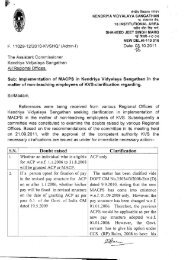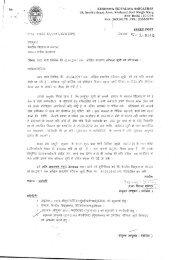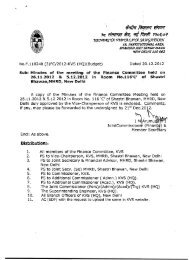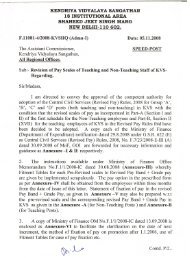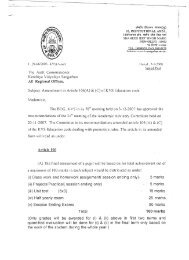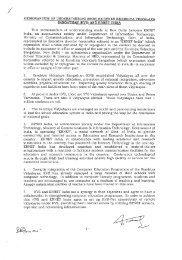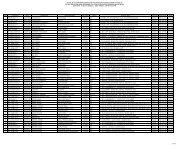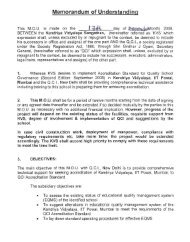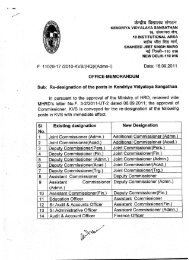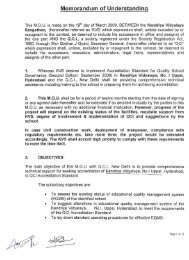Syllabus for written examination for PGT (Biology)
Syllabus for written examination for PGT (Biology)
Syllabus for written examination for PGT (Biology)
You also want an ePaper? Increase the reach of your titles
YUMPU automatically turns print PDFs into web optimized ePapers that Google loves.
<strong>Syllabus</strong> <strong>for</strong> <strong>written</strong> <strong>examination</strong> <strong>for</strong> <strong>PGT</strong>(CHEMISTRY)S.No.Topic (Details of the syllabus)1. Some Basic concepts of Chemistry: Scope of chemistry-Historical approach to nature of matter - states of matter, properties of matter and itsmeasurement, S. I system of units, Uncertainty in measurements, dimensional analysis,Laws of chemical combination, atomic and molecular masses, Mole concept and molarmasses, percentage composition, empirical and molecular masses, equivalent weight,concept of limiting reagent2 States of Matter: Gases, liquids and solids, three states of matter, types of intermolecular<strong>for</strong>ces.The laws governing ideal gas behaviour, Dalton’s law of partial pressure, Kinetic moleculartheory of ideal gases, Maxwell Boltzmann distribution law on molecular motion, real gases– deviation from ideal behaviour, vander Waals equation.Liquid and their properties.Solids: Classification of solids, fundamental types of lattices, two and three dimensionallattice types, Simple crystal structures, Trans<strong>for</strong>mation of crystal structure on varyingtemperature, Bragg’s law, density in solids, energy band, band gaps, semiconductors,magnetic and dielectric properties, stoichiometric and non- stoichiometric defects in solids.3 Structure of Atom:Structure of Atom (Classical Theory), Dalton’s atomic theory, Bohr’smodel of atom, Structure of atom (modern theory), de Broglie’s relationship, Heisenberg’suncertainty principal, Classical wave equation, Schrödinger’s wave equation, Probabilitydistribution curve, Quantum numbers, Pauli’s exclusion principle, Aufbau principle, Hund’srule of maximum multiplicity.4 Equilibrium: Reversible reactions, criteria of equilibrium, Law of mass action, equilibriumconstant, K c and K p , Le Chatelier principle, Ionic equilibrium, Ostwald’s dilution Law,solution of acids, bases, ionic equilibria in solution, Common ion effect – its applicationto qualitative analysis, acids and bases, Bronsted- Lowry theory of acids and bases, Lewisconcept of acid and bases, relative strengths of acids and bases, their quantitativeestimation, buffer solution and its use, determination of pH, theories of indicators,conductometric titration, Solubility product, hydrolysis.5. Surface Chemistry:Adsorption, absorption, sorption, Physical adsorption, Chemisorptionadsorption, isotherms ( Freundlich, Langmuir), application of adsorption, types of Catalysistheories of catalysis, classification of colloids, preparation of Colloidal Solution (lyophobicand lyophilic), Special characteristics of colloidal solutions , electrophoresis, Precipitation ofcolloids – Hardy Schulze law, multimolecular and macromolecular colloids, Emulsion andGels.6 Chemical Kinetics: Theories of reaction rates, rate of reaction , molecularity and order ofreaction, Fast reactions- Luminescence and energy transfer process, reactionmechanisms(Simple and complex reactions).7 Redox Reaction and Electrochemistry: Oxidation and reduction, redox reaction and itsapplication, oxidation number, Strong and weak electrolytes, activity coefficient,conductance and conductivity, Kohlrausch law, resistance and resistivity molar conductivity,equivalent conductivity, Qualitative and quantitative aspect of electrolysis, electrochemicalcell and electrolytic cell, Electrode and electrode potential and standard electrode potential,Electrochemical series and its applications, Nernst equation and its application, Equilibriumconstant and EMF of the cell.8 Solutions:Solution and its types, expression of concentration of solution, solubility andfactors affecting the solubility of a solid in a liquid (temperature and pressure), Vapourpressure of a liquid, Raoult’s law <strong>for</strong> both volatile and non volatile solute,Ideal and nonideal solution, Colligative properties, abnormal molecular masses and Van’t Hoff factor.9 Chemical bonding and Molecular Structure: Valence electrons and Lewis structures,Ionic bond, Covalent bond, Bond parameters ,Co-ordinate bond, polarity and dipolemoment, Quantitative idea of – valence bond theory, molecular orbital theory (LCAO),Concept of hybridization involving s, p, d orbitals, Hydrogen bond, Resonance.10. Thermodynamics:Macroscopic properties of the system, modes of transfer of energybetween system and surrounding, Phase transition, phase rule and phase diagram, FirstLaw, second law and third law, of thermodynamics. Internal energy and enthalpy of thereaction, their measurement and application, spontaneity of process, Entropy andspontaneity, Helmholtz and Gibb’s free energy, Thermodynamics of electrochemical cells.11. Classification of elements and periodicity in properties: Significance of classification,brief history of the development of periodic table, periodic laws, name of the elements withZ>100 according to IUPAC system, classification of elements into s, p, d, f –block elementsand their characteristics,Periodic trends in the properties of elements – Ionization enthalpy, Electron gain enthalpy,electronegativity, atomic radii, ionic radii, periodicity of valency or oxidation state.12. Hydrogen:Position of Hydrogen in periodic table, occurrence, isotopes, Preparation ofhydrogen, on small and commercial scale, hydrides, water, hard and soft water, heavywater, hydrogen peroxide, hydrogen economy, hydrogen as a fuel.13. General principles and processes of isolation of elements and s – block elements:Principles and methods of extraction, oxidation and reduction as applied to the extractionprocedures of Al, Cu, Zn and Fe.s – block elements, general introduction – Electronic configuration, occurrence,Anomalous properties of the first element of each group, diagonal relationship,



